(Juglans ailantifolia var. cordiformis)


A relative of Walnut, native to Japan.
Hardier and more vigorous than walnuts. Less prone to disease and more tolerant of wet climates.
Heartnuts have a reputation of being hard to shell but the varieties offered here have improved shelling capacity.
Flavour is somewhere between a walnut and a pecan. The nut is shaped like a heart. Mature trees produce over 100kg of nuts.
The stock is not grown from nut but is grafted from known varieties.
Heartnuts are generally not self-fertile so more than one cultivar should be planted.
They flower in early to mid-May and are sensitive to frosts.
They grow into big trees and need 10-12m spacing.
Trees are heat grafted under contract.
Nut production can begin as early as year 4 though it is more typically year 7 or 8.
A limited numbers of large specimen heartnuts are available. Call for more details.
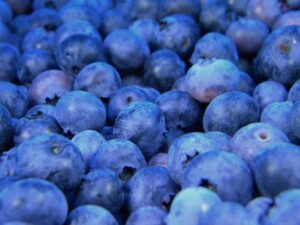
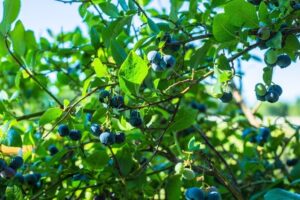
Blueberries like free-draining, acidic soil.
Optimum pH is 4.0-5.5
Two varieties should be planted together for pollination purposes.
Plant at 1.2-1.5m apart with 3-3.6m between rows.
Bluecrop
The most common variety, still providing the bulk of the global crop after half a century of dominance. Tall and vigorous with large fruit. Extremely reliable. Cropping late July to late August.
Blue Jay
Suitable for more sheltered sites. Very attractive pink flower buds opening into pure white flowers. Produces clusters of large firm berries with good flavour. Yields up to 7.5kg per plant. Cropping mid season, same as Bluecrop (which it is now replacing) but more concentrated cropping period.
Duke:
Spreading shrub growing to 1.6m, occasionallyn1.8m. Performs best when regularly pruned. Clusters of medium sized fruit with good flavour, regular and high yields. Good shelf life and transportation qualities. Less tolerant of wet soils. Early to mid season fruit. Late flowering so a good choice for frost prone sites. High disease resistance so suited to organic cultivation.
Goldtraube:
Very fast growing and robust cultivar. Berries large and aromatic. Performs well in poor conditions. Fruiting late July to end of August.
Cranberries (vaccinium macrocarpum)
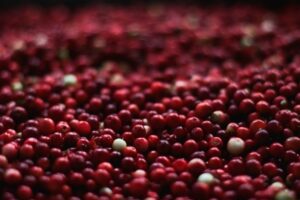

Long cultivated for it’s tart purple-red berries, popular in cranberry sauce, the American cranberry requires moist, free draining acidic ground to do well. Providing those conditions are met, it is very easy to grow.
Large scale commercial producers construct special beds that can be briefly flooded several times a year. This helps reduce certain pests (generally only a problem in large scale production), control weeds and also facilitates harvest.
However, for the small scale producer, cranberries can be easily grown on wide, slightly raised beds. An established bed will yield 1-2kg (occasionally 3kg) per m2 (10-20t/ha)
For Best results, the water table should be maintained at 30-60cm below the ground surface. The American cranberry does not thrive in permanently waterlogged or very dry ground. The ideal pH is 4.0-5.0 (upper limit 5.5)
The cranberry has massive potential in Ireland. Although trialled in the 1980s and 90s by Bord na Mona, the idea at the time was to compete on international markets. This proved unsuccessful.
For niche Irish markets, the cranberry has lots of potential. For small scale or low density production, cranberries are perfectly suited to organic methods. Cranberries combine well with aronia and apple for a sugar-free cranberry sauce.
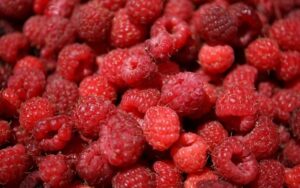
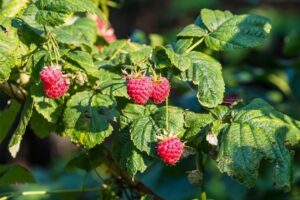
Raspberries thrive in fertile, slightly acidic soils. For highest yields, plant in a sunny, sheltered position. Though they will tolerate part shade.
Plants should be 45-60cm apart with 1.8m between rows.

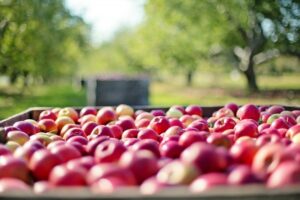
Almost all fruit trees and a high proportion of nut trees are grafted – that is, the fruiting part of the tree is grafted onto a separate rootstock. The choice of rootstock determines not just the ultimate size of the tree, but also factors such as disease or pest resistance, tolerance of poor ground or climate extremes, precociousness (ability to begin fruiting early in life), longevity, yield and ability to stand alone without long-term staking.
Apples are generally not self fertile so will require a pollinator from the same or adjacent pollination group. For example:a cultivar (variety) in pollination group 3 will require a pollinator from groups 2, 3 or 4. Triploids require a pollinator from the same or adjacent pollination group but will not provide reciprocal pollination. Hence the pollinator of a triploid requires its own separate pollinator.
Varieties available for 2021/2022 planting season:
Bramley’s Seedling:
Cooker producing large crops of large well flavoured fruit. Hardy and vigorous. Moderately high in vitamin C (16mg/100g). Good for juice or cider production. October to March. Pollination group 3 but triploid.
Discovery:
Eater. August. Possibly the tastiest of the early apples. Crisp with slight hint of strawberry. Bright red with pink coloured flesh. Does not keep. Homegrown ones are much tastier than the ones found in the shops. Pollination group 2/3.
Johnagold:
Triploid variety. Self-sterile and cannot pollinate other trees. Vigorous grower with large apples. Store well if picked just before they are ripe. Excellent for juice or cider. Harvest mid-October. Pollinator group 4.
Elstar:
Eater/Dessert apple. Fruit from late Autumn.
Braeburn:
Easy to grow. Produces a large crop early in its life. Stores well. Best eaten around November. Not as disease resistant as some other varieties.
Dabinet:
Full bodied cider apple. Small tree, moderately vigorous. Good overall disease resistance. Apples store well.
Katy:
Tasty eater. Very reliable cropper. Also good for juicing and cider. Resistant to canker. Ripens September/October. Pollination group 3.
Gala:
Crisp, medium sized apples. Sweet, mild flavour, Easy to grow and heavy cropper. Dual purpose cooker and eater. Pollinators include Braeburn and discovery. Striped or mottled orange or reddish appearance. Originating from New Zealand in the 1930s,
Johnagold:
(description needed)
Prins:
(description needed)
Boskoop:
Dual purpose apple used for both fresh eating and cooking as it holds its shape well when cooked. Firm and juicy apples with a sharp flesh and a full, tart flavour. A triploid and will require two pollinators.
All our plums are grown on St. Julian A rootstocks. This forms a moderately vigorous tree growing of 3-4 meters; fruits early in life. Fairly tolerant of poor soils.
Mirabelle de Nancy:
Yellow orange with green tinges. Small fruit. Very hardy. Mid to late September. Partially self fertile. Pollination group 1/2.
Victoria:
Heavy cropper for cooking and eating. Self fertile.
Opal:
Medium sized red/purple plum. Hardy and very reliable. Excellent flavour. Late July to early August. Self fertile. Pollination group 3
President:
President Plums produce an abundance of large blue/purple fruit. It is used for cooking and preserves but can also eaten fresh
Pollination partners include, Opal, Victoria, Mirabelle de Nancy and Merry weather.
Czar:
This large dark purple early-season plum is a top choice for cooking with. It can also be eaten fresh when fully ripe. The flesh is yellow and the stone is small and comes away easily. Self fertile and does not require a pollination partner.
Empress:
Empress produces large, firm sweet plums with a beautiful deep blue colour. Suitable for eating fresh, cooking and making preserves. Fruits abundantly and easily separates from the stone.
Early Prolific:
Early eating plum. Hertfordshire c1820. Fruit small but heavy cropping. Late July. Self fertile. Pollination group 2. Strongly recommended
Plumcot Plum x Apricot cross:
The Plumcot tree yields large sized fruit with yellow blushed, melon red skin. The Plumcot has a juicy, plum-like flesh with a unique aromatic touch of apricot flavour.
Golden Gage:
A self-fertile variety. The fruit is large and round with a yellow, transparent flesh. Excellent for bottling, freezing or eating fresh. The growth is upright and vigorous.
Green Gage:
A self-fertile variety. The fruit is large and round with a yellow, transparent flesh. Excellent for bottling, freezing or eating fresh. The growth is upright and vigorous.
Damson Merryweather:
A vigorous, self fertile tree. It produces large, blue-black fruits with a juicy yellow flesh. Can be used fresh when fully ripe in late summer and can also used for cooking jams and wine making. It is self-fertile and an excellent pollinator.
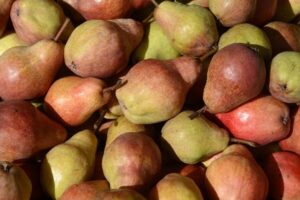
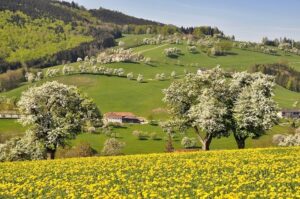
They do best in warm sunny locations where there is shelter from prevailing winds.
yields are much better when several varieties of the same or adjacent pollination group are planted together.
The trees should be planted in deep, well drained and fertile soil.
Eating and cooking varieties are generally supplied on Quince A rootstock. This is regarded as semi-vigorous. Trees should be planted 4-5m apart.
The varieties offered are likely to do well in Irish conditions. However, pears need warmth to ripen fully and ideally should be planted in sheltered sunny positions.
Perry pears are supplied on Pyrodwarf or Pyrus communis rootstock, and should be spaced at 5-10 m. The trees are very long lived – trees planted now may still be producing fruit in two hundred years time.
Varieties available.
Concorde Eater:
Compact tree, good for organic cultivation but fruit difficult to ripen in cool summers . Sweet and juicy. September. Regarded as being self fertile but does much better with a pollinator (pollination group 3).
Red favourite:
An excellent variety for your garden. Easy to grow with large creamy tasting pears. Used for both fresh eating and baking.
Beth Eater:
Compact tree which spurs freely. Sweet melting fruit. Very suitable for small gardens. September/October. Pollination group 3. Kent 1938.
Precoce De Travaux:
Eating. Small to medium sized fruit, yellow flushed with red. Exquisite flavour, scented, aromatic. Strong grower and resistant to scab. Good pollinator (pollination group 2), but slightly vulnerable to early frosts. One of the very best pears and one of our favourites. Mid August to early September. France 1862
Chrisite Eater:
Heritage Scottish variety. Sweet and juicy. September/October. Vigorous and hardy with good resistance to scab. Pollination group 3

Shrub native to Northern Asia and North America, long bred for its richly flavoured berries used in fruit juices and jams, or eaten raw. Important bee plant. Now known to be one of the richest sources of antioxidants, even superior to blueberries, sea buckthorn or goji berries. Planted commercially in North America, Russia, Poland, Germany, the Baltic States and Scotland (mainly for juice production). Yields are among the highest of any berry: three times that of blueberries and ten times that of goji berries.
Aronia juice is starting to appear in health food shops in Ireland, where it often sells for outrageous prices.
Easy to grow with good yields from the second or third year. An established bush can produce 10-15kg of berries per annum, with production continuing for thirty years or more.
When used as hedging, plant in single rows or staggered double rows, 1-1.5m between plants (0.7-1.2m with Hugin).
For better yields plant as stand-alone bushes 1.4-2.4m apart with 3-5 m between rows (the wider spacing if vehicle access is needed).
The picking season extends 4-6 weeks (longer if a number of different cultivars are grown), from late August.
Aronia is very frost hardy (won’t be killed off by a repeat of December 2010), tolerant of most soils. However, it is not suitable for very exposed maritime situations or waterlogged ground.
Cobnuts (Corylus Avelana)

Cobnut trees will grow in most well drained soils, and once established will live for many years. The commercial cultivation of cobnuts dates back to the 1600s in England and France. Commercial production of hazels/cobnuts continues to this day in China, the United States, Turkey and a number of European countries. On fertile ground, yields of 1.5-3 tonne per hectare are achievable. It’s necessary to plant more than one variety of cobnut in order to achieve good pollination. The Irish hazel may also work as a pollinator.
We use the word ‘cobnut’ to cover all cultivated varieties of the hazelnut (including filberts). Please note that cobnuts are not self fertile, for success plant two or more different varieties. This will ensure good pollination.
Cultivars Available:
Nottingham
U.K variety, also known as Pearson’s prolific. Medium to large nuts, good flavour, moderately strong grower. Storage ability good. Very reliable cropper, cropping from a very young age. One of the best choices for Irish conditions. Male flowers: mid-season. Female flowers: mid-season. Good pollinator for other varieties.
Webb’s Prize
UK variety. Medium to large nuts, excellent flavour, relatively weak grower producing compact trees, good where space is limited. Less prone to wind damage. Storage ability good. Very reliable cropper, one of the best choices for Irish conditions. Frequently produces rooted suckers, good for propagation. Male flowers: mid-season. Female flowers: mid-season. Good pollinator for other varieties.
Cosford
UK variety. Medium to large nuts. Moderate to good flavour, strong grower. Storage ability fair. Reliable cropper but yields can be low. Male flowers: mid-late season. Female flowers: mid-late season. Very good pollinator.
Kentish Cob
Main variety grown in UK though French or Spanish in origin. Medium sized nuts, excellent flavour, moderate grower. Storage ability poor; used exclusively for the fresh nut market. Cropping ability in Ireland variable, best on a warm site. Male flowers: early-mid season. Female flowers: mid season.
EMOA1
Recent Dutch cultivar producing well in trials in UK and Netherlands. Good yields of large nuts.
Hall’s Giant
Originally from Germany. Also popular in France (where it is called ‘Merveille de Bollwiller’) Large nuts, good flavour (very sweet), very strong grower. Storage ability good. Reliable cropper, good yields. A good choice for Irish conditions. Not always popular because of its very vigorous growth and thick-shelled nuts. Male flowers: mid-late season. Female flowers: late (needs a late flowering male for pollination)
All trees will be 2yr, 80cm+, single stem with some lateral branching. Except EMOA1 which are 3yr and already showing signs of nut production.

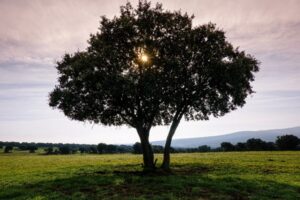
Throughout human history acorns have probably been eaten by indigenous people, and were highly prized by many hunter-gatherer cultures.
The Holm oak is hardy to about -15°C. Some specimens in Ireland were apparently killed by the unusually low temperatures of December 2010
Holm Oak (Quercus ilex)
The principal oak used for human food in the Mediterranean area and in Iberia. Evergreen. Very long lived tree, fully hardy in most parts of Ireland. Will produce first acorns at about ten years
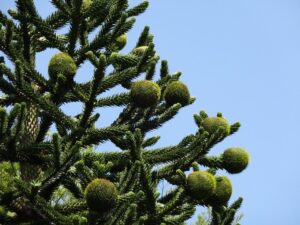
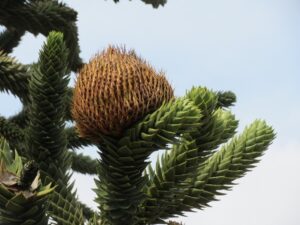
The Monkey Puzzle is native to the south-central Andes, the main habitat region being situated at latitudes between 37.5 and 39.5ºS. It is found mainly on the Chilean side, typically above 1000m. The climate is mild temperate and annual rainfall is 1250-2000mm (in one locality up to 4000mm).
In their native habitat Monkey Puzzle trees can grow up to 48m high and live for over 1200 years. Mature trees produce large cones, each of which contains up to 200 nuts.
The nuts are both tasty and nutritious and have been long prized as a food by indigenous peoples. In the wild, trees begin to produce nuts at around 25-40 years. However, there is strong evidence that cultivated trees begin flowering much earlier in life (early flowering in a common phenomena in cultivated seed-grown trees and may be partly due to root stress during the first few years). The first cones have been recorded on some cultivated Monkey Puzzle trees at around 15 years.
Popular as an ornamental tree, the Monkey Puzzle has been planted in many northern hemisphere countries and is found growing well as far north as 63ºN in western Norway. It will tolerate wet maritime climates, salt exposure, and winter temperatures down to -20°C.
Pollination
The trees are dioecious, meaning the female and male reproductive parts are on different trees. The trees offered here are seed-grown and will have female and male in approximately similar proportions. There is no way of determining the gender of the tree until flowering begins. For reliable nut production, at least six trees should be planted.
Our Monkey Puzzle trees
The trees are initially raised in a bed then transferred to a pot at year 2. Monkey Puzzles are very slow growing for the first 5-6 years.
Advice for planting
Trees for planting into final positions should be at least 4 years old and should be kept free of weeds for the first couple of year. When young, Monkey Puzzles are quite susceptible to Honey Fungus – a native fungus found in established woodland – and for this reason are best planted on grassland or other places where there was no previous woodland cover.
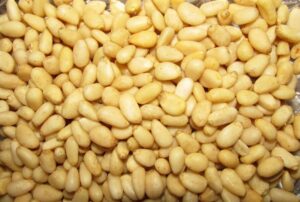
In Ireland , Pinus pinea is by far the most likely to produce regular crops of nuts. In coastal locations. Pinus torreyana has good potential while on more sheltered sites Pinus sabiniana, Pinus Coulteri and Pinus gerardiana are worth trying. The subalpine pines Pinus albicaulis, Pinus koraiensis and Pinus cembra also have good potential, but are very slow to come into production. Pinus pumila, the dwarf Siberian pine produces small nuts suitable for production of nut oil. In spite of its name, Pinus pumila grows quite quickly in Ireland, much faster than the subalpine pines listed above. All pine nut species are strongly outbreeding so single trees may not produce nuts. For best results plant 3-4 trees of the same species.
Pinus cembra
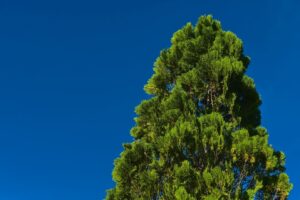 Pinus cembra , the Arolla stone pine, is native to the Alps and Carpathians, where it grows at a higher altitude than any other conifer. It is a very tough tree, capable of thriving in barren stony soil. In its harsh native environment it can take decades to reach nut-bearing age but when cultivated the first nuts appear at about 15 years. Requires well-drained soil. Slow growing, eventually reaching ten to twenty meters. Hardiness Zone 5. For best results, plant more than one tree.
Pinus cembra , the Arolla stone pine, is native to the Alps and Carpathians, where it grows at a higher altitude than any other conifer. It is a very tough tree, capable of thriving in barren stony soil. In its harsh native environment it can take decades to reach nut-bearing age but when cultivated the first nuts appear at about 15 years. Requires well-drained soil. Slow growing, eventually reaching ten to twenty meters. Hardiness Zone 5. For best results, plant more than one tree.
Pinus koraiensis
Pinus koraiensis , the Korean stone pine, is native to Korea, Northern China, the Pacific coast of Russia, and Northern Japan. Closely related to Pinus siberica, but thought to be more adaptable to Irish conditions. It should produce the first nuts after about 15 years. Can tolerate a wide range of soils. Will grow into a large tree. Also valuable for timber. For best results, plant more than one tree. Hardiness Zone 3. Grafted trees available
Pinus pinea
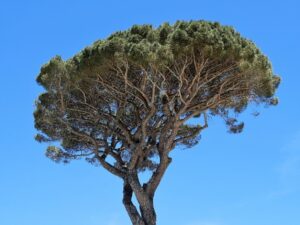
Pinus pinea, the Mediterranean stone pine, grows well in Ireland and will produce the first nuts after 8-10 years. It is a tough hardy tree, tolerant of frost to -15°C. It will grow in any well-drained soil. Very good in coastal locations. This is by far the best choice of pine nut tree for Ireland. Slow growing with spreading habit. Also valuable for fuel. For best results for nuts, plant a minimum of 3-4 trees. Hardiness Zone 8.
Pinus pumila
Pinus pumila, the dwarf Siberian pine, is native to the Russian Pacific coast, Northern Japan and parts of Korea and China. Closely related to Pinus koraiensis and Pinus siberica. It forms a dwarf tree or large shrub, occasionally reaching six meters. Compared to other pine nuts, the nuts are very small. In Siberia and parts of Japan the nuts are harvested for their oil. Of the pine nut trees offered here, the most suitable for really tough situations. Very suited to mass-planting in harsh coastal or upland environments. Compared to its subalpine relatives, grows relatively quickly in Ireland and could be used for as a nurse tree for other low growing species. Hardiness Zone 5.
Pinus siberica
Pinus siberica, the Siberian stone pine, is closely related to Pinus cembra, the Swiss Stone Pine, but produces larger nuts. It is a long-lived tree (c500 years) that in its native environment can grow to 30 metros. Although it has evolved to cope with the extreme temperature variations of Siberia and Mongolia, it appears quite comfortable in cool temperate climates. Known to be growing in coastal regions of some Baltic countries. Nut-producing capability in Ireland is unproven, but appears possible. Probably best on a cold upland site. The first cones should appear after about 15 years. Also valuable for timber and fuel. For best results plant more than one tree. Hardiness Zone 3.
Your Content Goes Here
